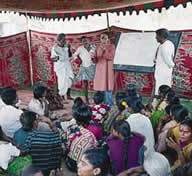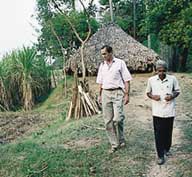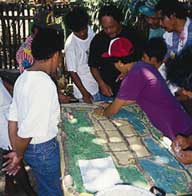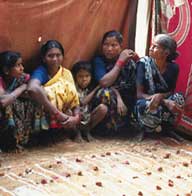Community Planning: Methods
Field workshop
- description
- more detail
- more pictures
Field workshops are a way for local communities to draw up plans of action where there is little data available to start with. They are particularly suited to disaster prevention work in developing countries.
Field workshops involve a team of technical experts working closely with a handful of local facilitators, local officials and many local residents of all ages, backgrounds and interests.
A programme of activities lasting several days or even weeks is prepared in advance involving community profiling, risk assessment and plan making methods. The programme is agreed in advance by all parties but may be varied at any point to allow for results to be built on and developed.
The aim is to develop a common understanding of the nature of the community, the issues faced and possible solutions.
The technical team presents its recommendations to the whole community a few days after the main activity sessions.
Field workshops involve a team of technical experts working closely with a handful of local facilitators, local officials and many local residents of all ages, backgrounds and interests.
A programme of activities lasting several days or even weeks is prepared in advance involving community profiling, risk assessment and plan making methods. The programme is agreed in advance by all parties but may be varied at any point to allow for results to be built on and developed.
The aim is to develop a common understanding of the nature of the community, the issues faced and possible solutions.
The technical team presents its recommendations to the whole community a few days after the main activity sessions.
Photocredits
top: Yellamanchilli, Adrapradesh, India, 1996, Nick Hall.
bottom: Yellamanchilli, Adrapradesh,India, 1996, Roger Bellers.
top: Yellamanchilli, Adrapradesh, India, 1996, Nick Hall.
bottom: Yellamanchilli, Adrapradesh,India, 1996, Roger Bellers.


Evolving a common view
Group working. Informal walk.
.
Tips
- Technical team members need to be sensitive to local cultures. Ask permission before taking photos or taping interviews.
Costs
- Planning a field workshop carefully in advance is essential if money is to be spent effectively. Materials need not cost much. The main costs will be people's time and accommodation and travel for the team.
Sample field workshop format
Example: Village suffering from typhoons.
DAY 1
DAY 2
DAY 3
DAY 4
DAYS 5-9
DAY 10
Example: Village suffering from typhoons.
DAY 1
-
08.00 - 08.10Ice breaker. Music. Dance.
08.10 - 10.00
Introductions. Participants introduce themselves. Aims and process explained.
10.00 - 12.00Personal history. A few participants tell their history.
12.00 - 13.00Historical profile. Key events listed in date order.
14.00 - 16.00Map drawing. Large map of village drawn on paper.
16.00 - 17.00Photo game. Photos of all buildings (taken previously) located on map. Discussion.
18.30 - 21.00Social. Music and dinner.
21.00 - 23.00Review session. Day's activities reviewed. Plans revised if necessary.
DAY 2
-
07.00 - 08.00 Review of Day 1.
09.30 - 12.00 Interviews. Key public figures explain their roles and are questioned.
09.00 - 13.00
Group AModel making. Model made of village showing hills, rivers, valleys and other main features.
09.00 - 13.00
Group B Map making. Map made (eg concrete, bamboo, mud, timber).
14.00 - 16.00 Simulation exercise. Disaster simulated to understand people's reactions. eg to typhoon)
16.30 - 17.30 Damage classification.Models and maps used to classify extent of damage (total destruction, damage to roof, partial damage etc)
19.00 - 21.00 Review and planning. Review of activities and process. Schedule revised.
DAY 3
-
08.30 - 12.00 Reconnaissance. Of buildings and sites identified in previous day's review.
09.00 - 12.00 Interviews. With key officials and politicians (by some).
13.00 - 16.00 Review session. For research team and facilitators. Information gathered so far structured using a matrix. Process reviewed.
13.00 - 20.00 Construction workshop. Scale models of houses built by local carpenters to identify structural problems. Queries by research team. Discussion.
15.00 - 19.00 Gender workshop. Participants divide into male and female groups. Analysis of different roles and responsibilities.
19.00 - 19.300Informal walk. For research team and facilitators.
DAY 4
-
09.00 - 13.00Interviews. Further questionsto key figures.
09.00 - 13.00 Construction workshop. Continued.
09.00 - 13.00 Gender workshop. Continued.
14.30 - 16.00 Summary session. Review of activities by research team.
14.30 - 16.00 Next steps. Workshop groups prepare list of recommendations.
19.00 - 24.00 Social. Dinner and music.
DAYS 5-9
-
All day Research and analysis. Research team prepares report and presentation.
DAY 10
-
20.00 - 22.00Presentation. Research team presents proposals to open community meeting.
Ideal numbers:
research team 4; facilitators 2; locals 20-50.


Evolving a common view
Model making (left). Mapping (right).
Photocredits
left: Igbalangao, Philippines, 1995, Nick Hall
right:Yellamanchilli, Adrapradesh, India, 1996, Nick Hall.
left: Igbalangao, Philippines, 1995, Nick Hall
right:Yellamanchilli, Adrapradesh, India, 1996, Nick Hall.
Thanks: Roger Bellers, Nick Hall